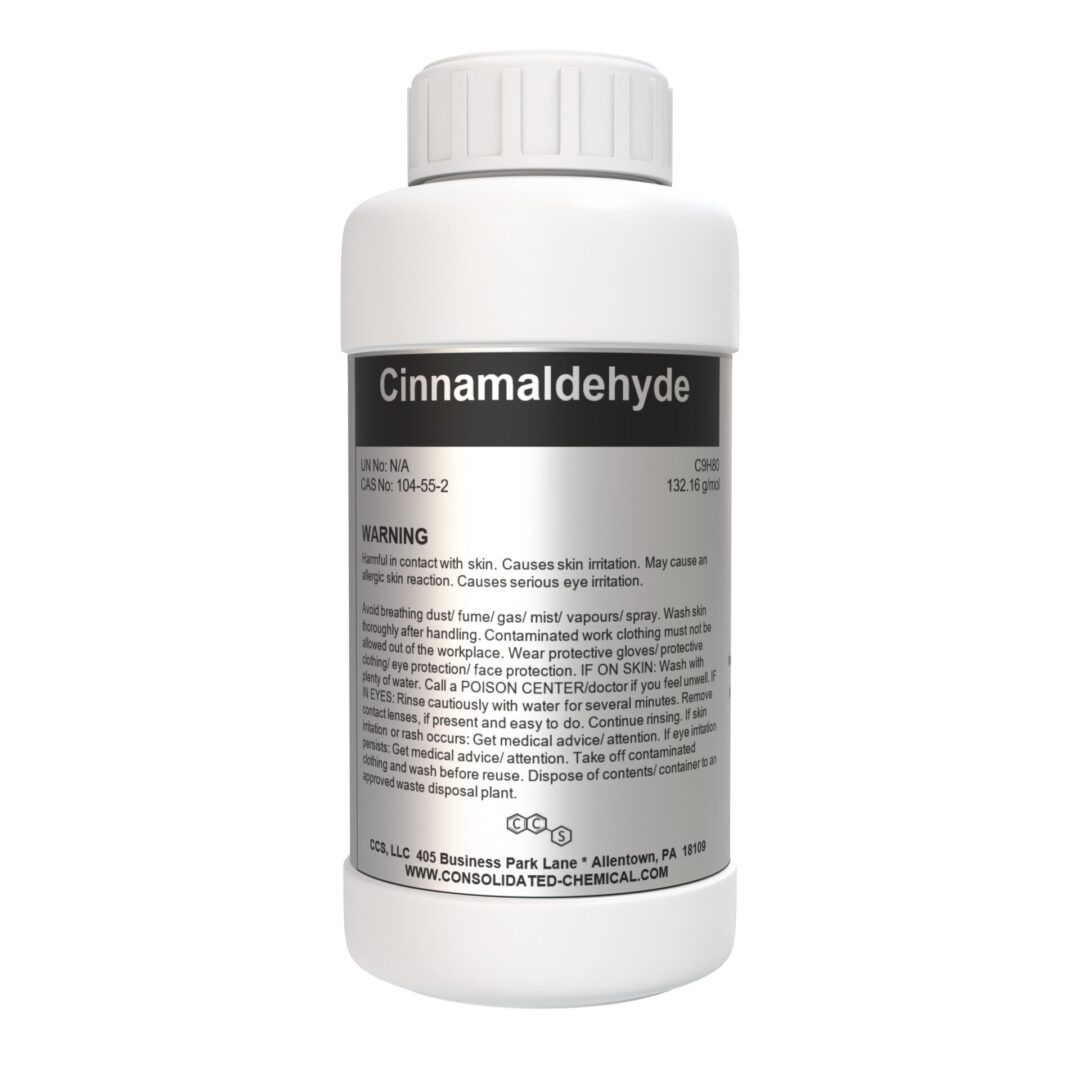Cinnamaldehyde – Natural Cinnamon Flavoring/Aroma Extract
$9.99 – $59.99
Chemical Identity:
- Chemical Name: Cinnamaldehyde
- CAS Number: 104-55-2
- Molecular Formula: C9H8O
- Molecular Weight: 132.16 g/mol
- Synonyms: (E)-Cinnamaldehyde, Cinnamic Aldehyde
Physical Properties:
- Appearance: Clear to pale yellow liquid
- Odor: Warm, spicy cinnamon aroma
- Density: ~1.05 g/cm³ at 25°C
- Boiling Point: 246°C (474.8°F)
- Melting Point: ~-8°C (17.6°F)
- Flash Point: ~71°C (159.8°F) (closed cup)
- Solubility: Insoluble in water; soluble in ethanol, acetone, and other organic solvents
Description
Cinnamaldehyde is a highly versatile compound known for its distinct cinnamon aroma and numerous applications in food, fragrance, and chemical industries. It serves as a natural flavoring agent, an aromatic additive in perfumes, and a precursor in chemical synthesis.
This Cinnamaldehyde is available in food-grade and industrial-grade formulations, ensuring suitability for diverse applications. Its high purity and consistent quality make it a trusted choice for manufacturers and researchers alike.
Applications of Cinnamaldehyde:
- Food Industry:
- Flavoring Agent: Used to add a warm, spicy cinnamon flavor to baked goods, candies, beverages, and condiments.
- Preservative: Exhibits antimicrobial properties, making it useful as a natural food preservative.
- Fragrance Industry:
- Perfumes and Colognes: Provides a rich, spicy aroma for high-end fragrances.
- Candles and Soaps: Adds a distinct cinnamon scent to candles, soaps, and other personal care products.
- Pharmaceuticals:
- Active Ingredient: Incorporated into formulations for its antimicrobial, antifungal, and anti-inflammatory properties.
- Aromatherapy: Used in essential oil blends for its calming and warming effects.
- Pesticides and Agriculture:
- Natural Pesticide: Acts as a biopesticide to repel or eliminate insects and pests.
- Fungicide: Used to combat fungal growth on crops and plants.
- Industrial Applications:
- Chemical Synthesis: A precursor in the manufacture of pharmaceuticals, flavor compounds, and organic chemicals.
- Corrosion Inhibitor: Protects metals and alloys in industrial systems.
- Personal Care:
- Oral Care: Used in toothpaste and mouthwash for its flavor and antibacterial properties.
- Skin Care: Found in cosmetics for its aromatic and preservative qualities.
- Health and Wellness:
- Aromatherapy: Valued for its soothing and invigorating properties.
- Natural Remedies: Used in traditional medicine to aid digestion and alleviate discomfort.
- Research and Development:
- Laboratory Use: Employed in studies and experiments as a reagent and organic compound for synthesis.
- Beverage Industry:
- Alcoholic and Non-Alcoholic Beverages: Adds flavor to spiced drinks, liqueurs, and teas.
- Cleaning Products:
- Adds a pleasant aroma to household cleaners and air fresheners, doubling as a mild antimicrobial agent.
Storage:
- Store in a cool, dry, ventilated area (15°C–25°C) away from heat, sunlight, and open flames.
- Keep in tightly sealed, labeled containers.
- Avoid storing near oxidizers, acids, or bases.
Handling:
- Wear gloves, goggles, and protective clothing. Use a respirator if necessary.
- Handle in a ventilated area or under a fume hood.
- Avoid contact with skin, eyes, and inhalation of vapors. Wash hands after handling.
Spill & Disposal:
- Clean spills with absorbent materials and dispose of per local regulations.
- Use licensed services for large-scale disposal.
Additional information
| Size | 15mL (0.5 Fl Oz), 30mL (1 Fl Oz), 100mL (3.3 Fl Oz), 250mL (8 Fl Oz), 500mL (16 Fl Oz), 1000mL (32 Fl Oz) |
|---|
Related products
-

Ferrofluid Celestial Blue Elegance Display (New & Improved Blue Colored 2oz)
$19.99 Read more -

Methyl Eugenol High Purity Aroma Compound
$11.00 – $39.99 Select options This product has multiple variants. The options may be chosen on the product page -

Copper (II) Carbonate – High Purity Solid
$14.99 – $45.00 Select options This product has multiple variants. The options may be chosen on the product page -

Sodium Percarbonate (Uncoated) Solid | Oxygen Bleaching Agent
$24.99 – $34.00 Select options This product has multiple variants. The options may be chosen on the product page
SKU: N/A
Categories: Flavoring Agent, Fragrance Chemical, Uncategorized
Tags: Antimicrobial cinnamon compound, Aromatherapy cinnamaldehyde, CAS 104-55-2, Cinnamaldehyde, Cinnamaldehyde flavoring, Cinnamaldehyde for agriculture, Cinnamaldehyde for baked goods, Cinnamaldehyde for beverages, Cinnamaldehyde for candles, Cinnamaldehyde for fragrances, Cinnamaldehyde for industrial use, Cinnamaldehyde for perfumes, Cinnamaldehyde for personal care, Cinnamaldehyde for pest control, Cinnamaldehyde for soaps, Cinnamon aldehyde, Cinnamon essential oil ingredient, Cinnamon flavoring agent, Cinnamon oil compound, Cinnamon-scented chemical, Food-grade cinnamaldehyde, High-purity cinnamaldehyde, Industrial-grade cinnamaldehyde, Natural biopesticide, Natural cinnamon extract, Natural cinnamon flavor, Natural flavoring compound, Organic cinnamon aldehyde, Pharmaceutical-grade cinnamaldehyde, Spicy aroma compound







